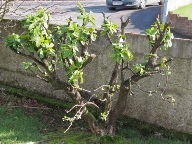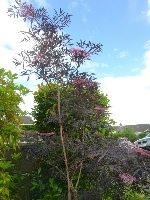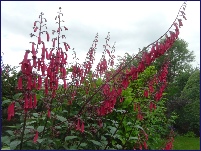







M mF edn e8





Because we expect to keep shuffling the Pools’ contents to make room for revisions and visitors’ responses, please refer to Pool_X, refreshing your browser or ‘phone on every visit, then refresh each Pool you visit too: otherwise they may lead you a merry dance.












c
14 July 2020

14/07/2020 / Alan Hamilton/ Seen in June:

12/07/2020 / Syd Harrod / Scale: Rhodo Cut Down.


Meet the victim -
All leaves but the top ones will be blacked out by sooty mould on Scale excreta unless we act now. Small plants can be kept free of scales by wiping them off the leaf undersides. A chemical spray if taken into the leaf sap can do the job, so long as it gets in there at the right season. The Scale hides its eggs inside waterproof cushions, so you must kill adult Scales before they lay (years ago, winters were cold enough to do it), or kill all the Scales after they emerge. I’d tried for two seasons.
re: slow blackout for Camellia, Holly, Rhododendron etc.
Our victim was 8 ft high and it grew very densely, making it hard to spray all of the Scales. Also, time to spray was limited by wind, rain, and the bush leaning over a public pavement.
In the Summer of 2019 we cut and sawed off all prospects of bloom in 2020, aiming to compel the plant to break into new growth below knee level. I did hope that even old bark would still be pliant enough to allow latent buds to break through it and establish secure new branches. With low branches established I could train the bush to veer away from the garden wall and the pedestrians. Of course, I had to leave enough sure prospects of fresh new foliage to keep the roots pumping sap in 2020. No 2018 leaf survived my onslaught, but as you see above, we had a fair coverage of new growth ready to survive the winter.
5 March ‘20
Not knowing the name or ancestry of our plant, I wasn’t surprised by the absence of any shoots emerging at the desired low levels, but I was disappointed. June 2020 was wet and windy, causing soft extension and ripping some shoots from tough bark, but the trimming and disbudding should leave us with a compact and winter-
So far we have found only one adult Scale insect and one cushion, and Summer has since brought occasions dry and calm enough for spraying while the foliage is soft enough for the insecticide to become systemic: I hope.

20 June ‘20
Inspection on eighth of April showed every leaf was Scale-


The cool temperature and the moist conditions have helped
the onions and potatoes, while the Sweetcorn is growing well in the greenhouse. It is about to flower and spread the pollen.
Elderflower (Sambucus) 'Black Lace' is lovely at this time of year.


I will need to keep it pruned. The red perennial is called Lychnis chalcedonica, having been introduced via Malta from further eastward (?Chalcedon): it’s also commonly called the Maltese Cross, though there's no proof that it ever caused any trouble there.


splash of white in the garden. The plants grow quickly and I need to divide the clump. Daphne got some roots from me and it is growing well in her garden.
This white Peony is quite an upright form and gives a good


Phyglius (Red Emperor) or Cape Fuchsia. It needs to be cut back each winter to stop it taking over the border but the flowers are quite long lasting.
Alan .
Some lovely blue Siberian Irises, and a few yellow Irises in the background

